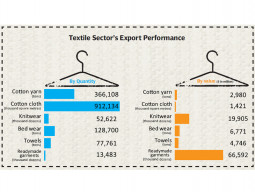
LONDON:
Durree is a traditional rug weaved on handlooms in different parts of India and Pakistan. Gakkhar Mandi, a market town in Gujranwala district, has for decades been associated with quality durree manufacturing. There was a time when one could not find a house, mosque or tent services business which did not have colourful durrees of all types (for beds and floors), which had been manufactured on handlooms in Gakkhar Mandi.
This traditional cottage industry has been on a sliding slope for many ye ars. Due to numerous crises, many families have left the industry, and those still in business find it difficult to retain master artisans whose younger generations are shifting to more lucrative and ‘better-respected’ professions.
There are a number of factors that have contributed to the fall of durree manufacturing in Gakkhar. These reasons are similar to the decline of other traditional craft businesses like khes (a patterned and bound double weave cloth, woven in certain areas of the Punjab and Sindh and used as bedcovers, curtains and floor covering) and loi (a traditional woollen shawl) in different provinces.

These include a decrease in the use of charpoys, especially in the urban areas, and their replacement with the modern beds, which are preferred with foam mattresses. Consequently, durree is fast disappearing as a dowry item in the cities.
Change in culinary habits and eating styles during festivities (marriages, birthday parties and even religious occasions), with sitting arrangements on chairs and eating while standing preferred rather than the old custom of sitting on floors carpeted with durrees has also contributed to a fall in demand.
Meanwhile socio-political instability in the northern areas and parts of Afghanistan has affected exports of durrees to tribal areas.
In addition to the above, an economic factor that has significantly contributed to the predicament of this cottage industry is the availability of cheaper substitutes (like synthetic carpets and plastic sheets), which have driven the better quality durrees out of the market. Apparently, Gresham’s Law (bad money drives the good money out of the market) is in action even in the durree market. In order to compete with the cheaper substitutes, the manufacturers of durrees have also started producing lower quality products in an attempt to minimise costs.
The major reason for the collapse of durree manufacturing is the cost of cotton, the main raw material used in the production process. It is almost 40% costlier to produce a traditional durree as compared to a synthetic carpet. In the wake of the increase in costs of production and the price elastic demand of durrees (in the presence of the cheap substitutes), durree manufacturers have resorted to decreasing the weight of durrees produced (while maintaining the size in terms of length and width). This has certainly affected the quality of durrees, which has a further dampening effect on their demand.
In the Western world, there is a renewed interest in handicrafts and handmade consumer items. There is a need to create awareness of this issue amongst the masses, and to convince them to patronise traditional products. Otherwise, the traditional art of weaving on handlooms will disappear, like many other businesses that are now extinct and considered merely cultural vestiges of our rich past.
There is also a potential business opportunity here for some big players to plug products like hand-woven durrees into the global fair-trade movement to tap an ever-increasing market of ethically-driven consumers. If manufacturers can earn a higher price, commensurate with the quality of their products, they will be able to pay higher wages to artisans who otherwise are migrating to better-paid labour activities.
There is also a need to declare this dying industry tax-free, so that incumbent families in the business invest more into their businesses to increase the size of individual units. At present, there is a flat rate of tax on a unit with up to eight handlooms, after which the tax increases significantly. This has resulted in a decrease in the size of durree factories, as most of the handlooms are now scattered in houses around the town and the neighbouring villages. Once there were over 100 factories in the town, each employing no less than 100 artisans (ie, no less than 100 looms), employing about 10,000 skilled workers. This number has gone down to no more than a few hundreds. In a country where both unemployment and inflation are acute, revival of such traditional businesses can prove to be a good measure for economic development and deepening of business linkages.
THE WRITER IS AN ECONOMIST AND A PHD FROM CAMBRIDGE UNIVERSITY
Published in The Express Tribune, April 1st, 2013.
Like Business on Facebook to stay informed and join in the conversation.



































































COMMENTS
Comments are moderated and generally will be posted if they are on-topic and not abusive.
For more information, please see our Comments FAQ